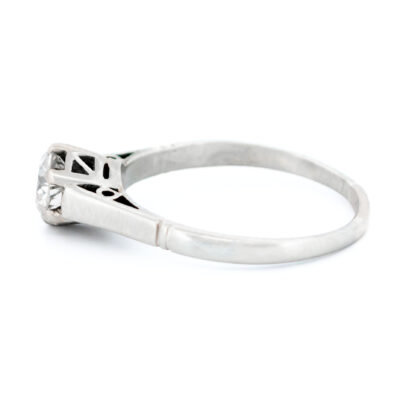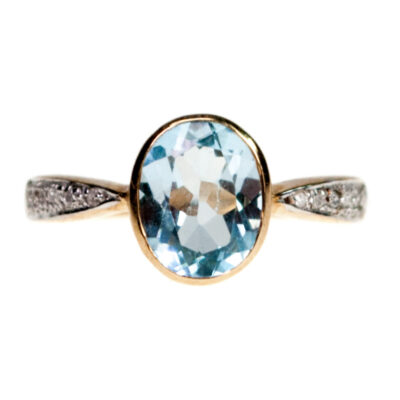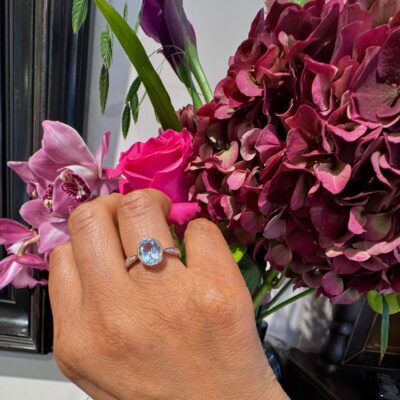A timeless blend of elegance and charm, this vintage ring features a 0.25ct brilliant-cut diamond, sparkling with an H SI1 clarity and color grade. Accented with 0.22ct G SI1 baguette diamonds, the yellow and white 14k gold band exudes sophistication, making it perfect for a lifetime of memories. 💎
Details: ±0.25ct (H SI1) Brilliant-cut diamond, ±0.22ct (G SI1) Baguette-cut diamonds, 14k Ring.
Design Era: Vintage.
Size: 16.5 NL / 52.0 FR / 6 US / L½ UK, sizeable (Within reason. Contact seller for information).
Weight in grams: 2.2.
Condition: Very good condition – slightly used with small signs of wear.
Shipping and Pickup: This magnificent piece ships from our store located in the center of Amsterdam, The Netherlands. We offer both registered shipping and local pickup at our store. In the case of local pickup, any applicable shipping costs will be refunded.
About Us: Add some sparkle to your style with Binenbaum.com. We offer a stunning selection of antique and vintage jewelry that you won’t find anywhere else. From timeless rings and dazzling necklaces to unique brooches, we have something for every taste and occasion. Visit our website today and treat yourself to a piece of history.
| Design Era | |
|---|---|
| Design & Historical Context | Vintage jewelry refers to jewelry that was produced a certain number of years ago, typically at least 20 years or more. It is often characterized by its unique style, craftsmanship, and use of materials that are no longer in production or are hard to find. Vintage jewelry can be made from a wide variety of materials, including gold, silver, platinum, and diamonds, as well as less precious materials such as costume jewelry or Bakelite. It can be influenced by a variety of styles and movements, including Art Deco, Art Nouveau, and Retro. One of the key features of vintage jewelry is its uniqueness and individuality. Unlike modern jewelry, which is often mass-produced, vintage jewelry is often one-of-a-kind or part of a limited production run. This makes it highly collectible and sought after by collectors and vintage enthusiasts. Vintage jewelry is often associated with a sense of history and nostalgia, and it can be a way to connect with the past and appreciate the craftsmanship and artistry of earlier periods. It is highly collectible and can be found at vintage stores, antique shops, and online marketplaces. |
| Key Materials | |
| Materials & Craftsmanship | Brilliant-cut diamond: The Pinnacle of Sparkle and Brilliance The brilliant-cut diamond is the most popular and widely recognized diamond cut in the world, renowned for its exceptional sparkle and fire. This cut, perfected over centuries, is designed to maximize the reflection of light, creating the dazzling brilliance that has made it the standard for diamonds in modern jewelry. The brilliant cut features 58 facets—33 on the crown and 25 on the pavilion—carefully arranged to capture and reflect light from every angle. The precision of these facets ensures that light entering the diamond is reflected internally and dispersed into a stunning array of colors, giving the stone its characteristic brilliance. Historically, the brilliant cut evolved from earlier cuts like the Old European and rose cuts, with advancements in diamond cutting technology and understanding of light reflection. This modern cut became widely adopted in the early 20th century and quickly became the preferred choice for engagement rings and other fine jewelry, due to its unmatched sparkle. In modern jewelry, brilliant-cut diamonds are prized for their versatility and unmatched brilliance. They are the go-to choice for engagement rings, earrings, pendants, and virtually any jewelry piece where a classic, sparkling diamond is desired. The round shape and symmetrical design make the brilliant cut ideal for showcasing the inherent beauty of the diamond, regardless of its size. A brilliant-cut diamond is more than just a gemstone; it is a symbol of timeless beauty and perfection. Its unparalleled sparkle and universal appeal make it the quintessential choice for jewelry that celebrates life's most precious moments. Baguette-cut diamond: The Gem of Sleek Elegance and Sophistication The baguette-cut diamond is a timeless and sophisticated choice in the world of fine jewelry, known for its sleek, elongated shape and understated brilliance. Named after the French word for stick or rod, the baguette cut features a rectangular form with step-cut facets that create a clean, elegant look. Historically, the baguette cut rose to popularity during the Art Deco period of the 1920s and 1930s, a time when geometric shapes and linear designs were all the rage. This cut was often used in combination with other shapes, such as round or emerald-cut diamonds, to create intricate and symmetrical designs that defined the era. The baguette cut's straight lines and minimalist appeal made it a perfect fit for the modernist trends of the time. In modern jewelry, baguette-cut diamonds are prized for their versatility and sleek appearance. They are commonly used as accent stones in engagement rings, flanking a larger center stone to add extra sparkle and balance. Baguette diamonds are also popular in eternity bands, bracelets, and earrings, where their clean lines and subtle brilliance create a refined, sophisticated look. Unlike brilliant-cut diamonds, which are designed to maximize sparkle, baguette-cut diamonds have fewer facets and a more subdued brilliance, focusing instead on clarity and the stone's natural beauty. This makes them an excellent choice for those who appreciate a more subtle, yet elegant, aesthetic. A baguette-cut diamond is more than just a gemstone; it is a symbol of refined taste and timeless style. Its sleek, geometric form and historical significance make it a perfect choice for jewelry that embodies both modern elegance and classic sophistication. 14k: The Durable Choice for Everyday Elegance 14k gold is a popular and practical choice in fine jewelry, known for its durability, affordability, and beautiful color. The 14k signifies that the gold is composed of 58.3% pure gold and 41.7% alloyed metals, such as copper, silver, nickel, or zinc. This combination results in a strong and resilient material that can withstand the rigors of daily wear, making it an ideal option for those seeking both beauty and durability. Historically, gold has always been a symbol of wealth and luxury, and 14k gold strikes a perfect balance between the rich appearance of gold and the strength needed for everyday use. Because of its lower gold content compared to 18k or 24k gold, 14k gold is more affordable, making it a popular choice for a wide range of jewelry pieces. In modern jewelry, 14k gold is appreciated for its versatility and variety. It is available in several colors, each achieved by mixing gold with different metals: Yellow Gold: A classic and timeless choice, 14k yellow gold has a warm, golden hue that complements most skin tones and is well-suited for both modern and traditional designs. White Gold: Created by alloying gold with white metals like nickel or palladium, 14k white gold has a sleek, silver-like appearance. It is often rhodium-plated for added shine and is a popular choice for engagement rings and other contemporary jewelry. Rose Gold: Achieved by mixing gold with copper, 14k rose gold has a soft, pinkish hue that has gained popularity for its romantic and vintage appeal. It is a favorite for those seeking a unique and stylish alternative to traditional gold colors. 14k gold is commonly used in a wide array of jewelry, including rings, necklaces, bracelets, earrings, and watches. Its durability makes it especially suitable for pieces that are worn daily, such as wedding bands and engagement rings, where the balance between strength and beauty is crucial. 14k gold is more than just a practical choice; it is a symbol of enduring style and everyday luxury. Its ability to retain the look of gold while offering greater resistance to scratches and dents makes 14k gold a versatile and timeless option for any jewelry collection. Whether in a simple band or an elaborate design, 14k gold offers a perfect blend of elegance and durability that can be enjoyed for years to come. |
| Size | |
| Gender | |
| Weight (in grams) | 2.2 |
| Condition | Very good condition – slightly used with small signs of wear |
By following these tips, you can enjoy your precious jewelry for many years to come.
Related Products
-
Diamond 18k Solitaire Ring 17512-9219
€ 2.895,00 VAT incl. (where applicable) -
Diamond 14k Solitaire Ring 17506-9217
€ 1.495,00 VAT incl. (where applicable) -
Diamond 18k Solitaire Ring 14061-8278
€ 2.995,00 VAT incl. (where applicable) -
Citrine Diamond 14k Solitaire Ring 13156-5052
€ 2.295,00Original price was: € 2.295,00.€ 1.850,00Current price is: € 1.850,00. VAT incl. (where applicable) -
Diamond Platinum 18k Solitaire Ring 7438-0749
€ 2.295,00 VAT incl. (where applicable) -
Diamond 14k Solitaire Ring 17511-9218
€ 3.695,00 VAT incl. (where applicable) -
Diamond Sapphire 14k Solitaire Ring 16107-8721
€ 1.695,00 VAT incl. (where applicable) -
Topaz Diamond 14k Solitaire Ring 11978-7266
€ 1.395,00 VAT incl. (where applicable)
- Home
- Collection
- Fine Jewelry
- Silver Jewelry
- Silverware
- Boxes
- Candlesticks
- Salt and pepper shakers
- Miniatures
- Salt cellars
- Spoon Set
- Condiments
- Frames
- Napkin Ring
- Spoon
- Oddities
- Cups
- Vases
- Cutlery
- Serving Spoon And Cake Server
- Candlesticks
- Baskets
- Hanukkiah
- Spice Tower
- Yad
- Tea Set
- Sugar Castor
- Napkin Rings
- Wine Bottle Coaster
- Wine Stopper
- Tea Pot
- Jugs
- Rattles
- Hip Flask
- Miscellaneous
- Rings 💍
- About
- Contact



















